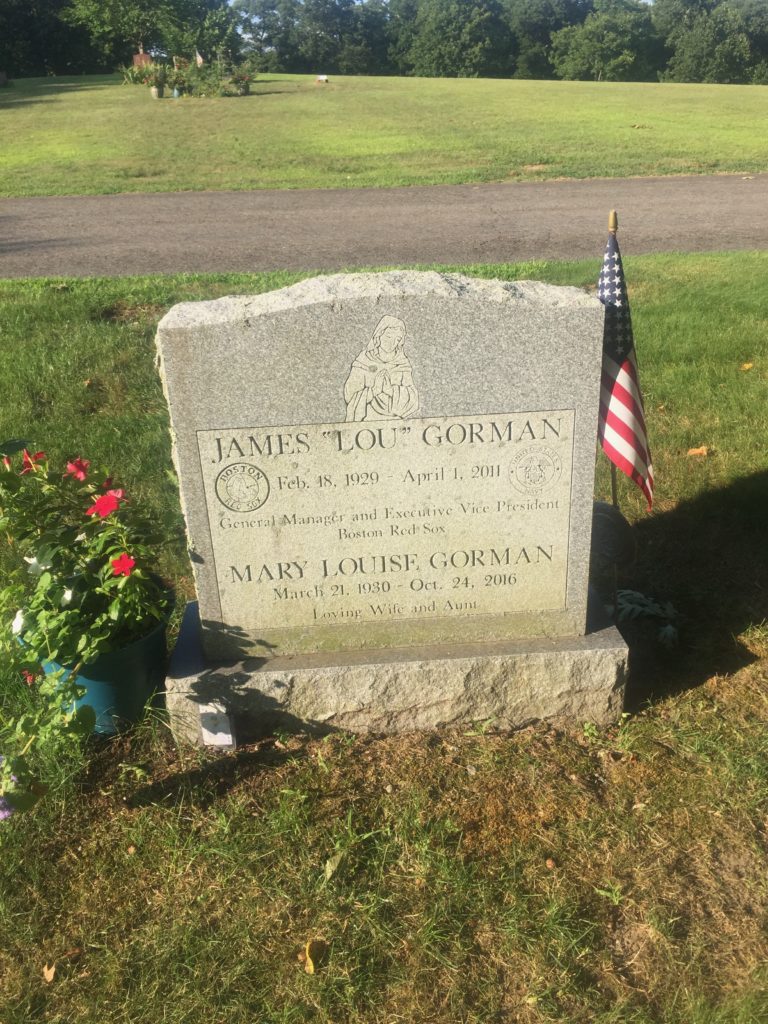Erik Visits an American Grave, Part 710
This is the grave of Lou Gorman.

Born in 1929 in Providence, Rhode Island, Gorman was a huge baseball fan. He played high school ball at La Salle Academy, the city’s most prominent Catholic school. In fact, his given name was James but he was nicknamed Lou after Lou Gehrig. He was a good high school ball player…but a good professional ball player, no. In 1948, he signed with the Class B Providence Grays where he went 1-28 and was cut. That was it for him.
Gorman went to Stonehill College, joined the Navy for eight years, served two tours in Korea, and then spent then next 26 years in the Reserves. After his active duty, he got a master’s degree in education at Bridgewater State. He received that in 1961. But baseball was still calling. He got hired as GM of the Lakeland Giants in a Class D league and then the next year with the Kinston Eagles for a Class A team in the Pirates system. He was a good developer of talent and by 1964 was working for the Orioles as assistant farm system director. In 1966, he was promoted to director of player development. In 1968, the Royals hired him to be farm system director; within a few years he was assistant general manager.
In 1977, a new team was born. It was the Seattle Mariners. Sigh. As a Mariners fan, it is so horrible. It’s just hopeless. With the exception of 1995-2003, the franchise has been horrible and while it was great those 8 years, it never even made the World Series, despite setting the all-time wins record in 2001. In any case, the early years of the Mariners were an atrocity. The best player in team history before Ken Griffey Jr. was either Alvin Davis or Mark Langston. Think about that. 15 years and that was as good as it got. Well, Lou Gorman was the first GM of the Mariners who helped put together this fine, fine tradition. Now, I can hardly blame Gorman for having crappy teams in the early years. It was an expansion team after all. But that doesn’t mean I can’t use this moment to express my frustration and perhaps punch a pillow. Gorman was GM from 1977-80. Nothing good happened in those years.
After the 1980 season, the Mariners decided to move on to another, poor, option. Gorman was hired by the Mets as VP of player personnel. He helped build what would become of the great teams of the 80s. But before that reached fruition, he became GM of the Red Sox in 1984 after that team worked through a tricky ownership battle. Now, to be honest, the core of the excellent Red Sox teams of that era were already set–Clemens, Boggs, etc. But Gorman made smaller moves to build up the team, trading for Dave Henderson from Seattle (he had drafted Hendu in perhaps his best Mariners move) and Calvin Schiraldi. After the Sox lost in 1986, Gorman went all-in for trading the team’s rising talent for established players that could help them win a title. This included perhaps the worst trade in Major League history, when he moved a young Jeff Bagwell to Houston for Larry Andersen. Ouch. After Gorman retired, he defended the move in his autobiography, noting that Bagwell was playing 3B at the time, the team had Boggs, and he considered such lights of the game as Tim Naehring and Scott Cooper better prospects. Well Lou, that poor ranking of your prospects is on you. He also traded Curt Schilling and Brady Anderson in trade deadline deals. That is…not good.
To be fair, Gorman and his staff did a pretty good job in developing players, both the future stars they traded away, but also a whole lot of pretty good players who would be good Sox: Mike Greenwell, Mo Vaughn, Aaron Sele, Ellis Burks, Jody Reed, etc. Not bad. But this was not enough to keep the team at the top level of the AL East with the rise of the Blue Jays. While Gorman was trading away his future stars, Pat Gillick was trading for Joe Carter and Roberto Alomar and Devon White and getting huge late career performances from Paul Molitor and Dave Winfield. The Sox won the AL East in 90 but faded very quickly after that, with major free agent signings such as Frank Viola and Jack Clark failing miserably. In 1992, the team finished last for the first time in 60 years. Gorman got one more year, but was fired after the 1993 season. Well, technically he was kicked upstairs into less important positions and stayed with the team in various positions through the 1996 season.
In his later years, Gorman served in various semi-ceremonial positions around the baseball world as a senior figure in the game. He wrote two books about his time in baseball, one of which has a forward from Doris Kearns Goodwin for some reason. He died in 2011, at the age of 82.
Lou Gorman is buried in Linwood Cemetery, Weston, Massachusetts.
If you would like this series to visit other general managers from baseball, you can donate to cover the required expenses here. Branch Rickey is in Rushtown, Ohio and Larry MacPhail is in Cass City, Michigan. Previous posts in this series are archived here.


